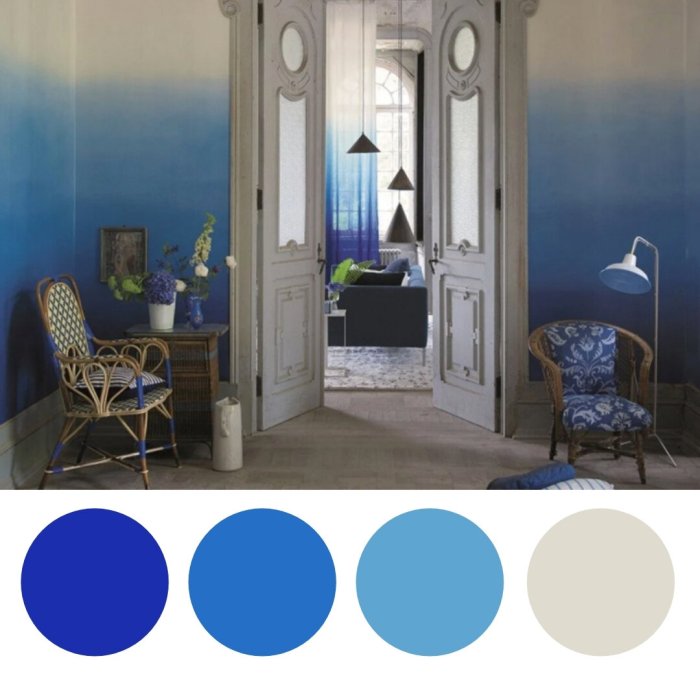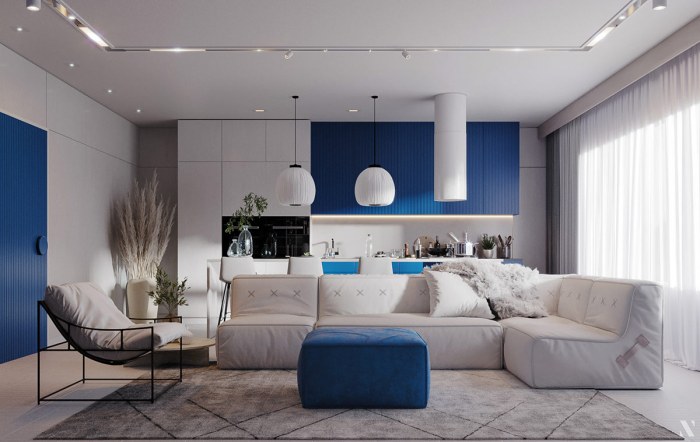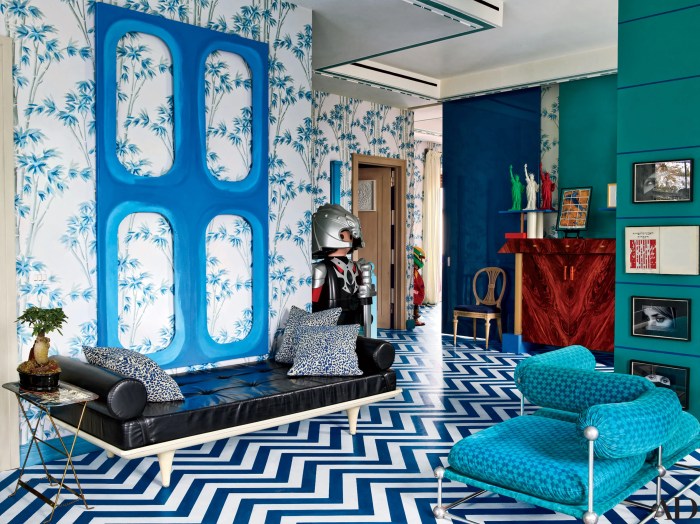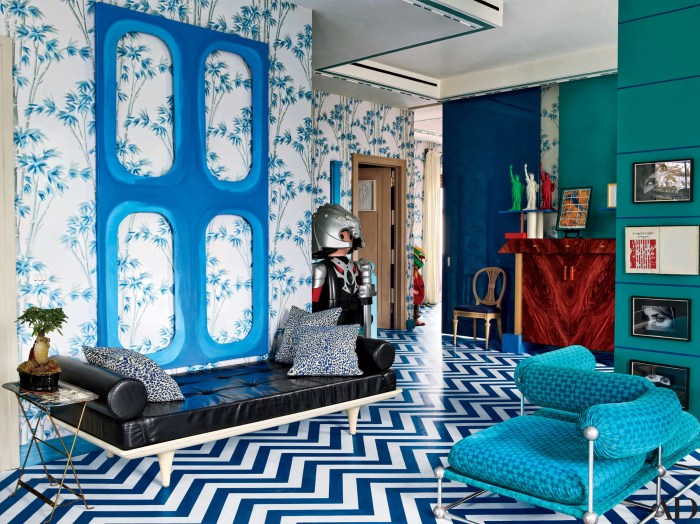Blue house interior design is a timeless and versatile choice that can evoke a wide range of emotions, from tranquility to vibrancy. The color blue, with its vast spectrum of hues, has the power to transform a space into a sanctuary, a haven of peace, or a stimulating environment that sparks creativity.
This guide delves into the world of blue interiors, exploring its psychological impact, design applications, and the endless possibilities it offers.
From the calming blues of a coastal retreat to the bold accents of a modern loft, blue can be tailored to suit any aesthetic and personal preference. This exploration will cover the nuances of different blue shades, their complementary colors, and how to incorporate blue into various elements of interior design, including furniture, decor, lighting, and materials.
We’ll also examine the use of blue in different room types, small spaces, outdoor areas, and sustainable design practices.
The Psychology of Blue

Blue is a color that evokes a wide range of emotions and psychological responses. It is often associated with feelings of calmness, serenity, and trust. In interior design, blue can be a powerful tool for creating a variety of moods and atmospheres.
The Emotional Associations of Blue
Blue is a versatile color that can evoke a variety of emotions, depending on its shade and context.
A blue house interior design can evoke a sense of tranquility and sophistication. If you’re looking for inspiration, you might want to explore the classic elements of american style house interior design , which often features warm wood tones, comfortable furniture, and a touch of Americana.
These elements can be incorporated into a blue house interior design to create a cohesive and inviting space.
- Light blues, such as sky blue and baby blue, are often associated with feelings of peace, tranquility, and serenity. These shades can be used to create a calming and relaxing atmosphere in a space.
- Medium blues, such as teal and turquoise, can evoke feelings of stability, trust, and communication. These shades can be used to create a sense of security and openness in a space.
- Dark blues, such as navy and indigo, are often associated with feelings of sophistication, power, and authority. These shades can be used to create a sense of elegance and formality in a space.
The Psychological Effects of Blue
Blue is known to have a number of psychological effects on humans.
- Blue can lower blood pressure and heart rate, promoting relaxation and reducing stress.
- Blue can also improve sleep quality by calming the mind and body.
- Blue can stimulate creativity and productivity by promoting focus and concentration.
The Use of Blue in Interior Design
Blue is a popular choice for interior design because of its versatility and ability to create a variety of moods.
- Light blues are often used in bedrooms and bathrooms to create a calming and relaxing atmosphere.
- Medium blues are often used in living rooms and dining rooms to create a sense of stability and trust.
- Dark blues are often used in offices and libraries to create a sense of sophistication and authority.
Examples of Blue in Interior Design
Here are some examples of how blue can be used to create different moods in interior design:
- A bedroom painted in a light blue can promote relaxation and sleep.
- A living room with teal walls and turquoise accents can create a sense of stability and communication.
- An office with navy blue walls and accents can create a sense of sophistication and authority.
Blue in Different Styles: Blue House Interior Design

Blue, a versatile hue, effortlessly adapts to various interior design styles, adding depth, tranquility, and visual interest to any space. From the cool sophistication of modern to the warm charm of farmhouse, blue’s ability to evoke different moods and emotions makes it a timeless favorite.
Modern Blue
Modern interiors embrace clean lines, minimalist aesthetics, and a focus on functionality. Blue in this style often appears in bold, saturated hues like cobalt, navy, and teal, adding a touch of drama and sophistication.
- Statement Walls:A vibrant cobalt blue wall serves as a striking backdrop for minimalist furniture and sleek accessories. The bold color adds depth and personality to the space, while the clean lines of the furniture create a sense of order and balance.
- Geometric Patterns:Geometric patterns in shades of blue, such as a teal and white chevron pattern on a rug or a navy and white geometric wallpaper, add visual interest and texture to the space. The patterns complement the modern aesthetic while adding a touch of playfulness.
- Metallic Accents:Combining blue with metallic accents, such as gold or silver, elevates the modern aesthetic. A cobalt blue sofa paired with gold throw pillows or a teal coffee table with silver legs creates a luxurious and sophisticated look.
Blue in Different Rooms

Blue is a versatile color that can be used in any room of the house, from the living room to the bathroom. However, the specific shade of blue and the way it is used will vary depending on the room’s function and desired atmosphere.
When using blue in different rooms, it is important to consider the specific needs and functions of each space. For example, a living room should be inviting and comfortable, while a bedroom should be calming and relaxing. A kitchen should be bright and cheerful, and a bathroom should be clean and refreshing.
Living Room
A blue living room can be a great way to create a sense of calm and relaxation. Light blues can create a sense of airiness and spaciousness, while darker blues can add a touch of sophistication and drama.
- A light blue sofa with white throw pillows can create a classic and elegant look.
- A navy blue rug can add a touch of sophistication to a neutral living room.
- Blue and white striped curtains can add a nautical touch to a living room.
Blue can also be used to accent a living room. For example, a blue vase filled with fresh flowers can add a pop of color to a neutral room.
Bedroom
Blue is a popular choice for bedrooms because it is associated with calmness and relaxation. Light blues can help to create a serene and tranquil atmosphere, while darker blues can add a touch of luxury.
A blue house interior design can be both calming and invigorating, depending on the shades of blue you choose. If you’re looking for a more dramatic contrast, you might consider incorporating elements of a black and white interior house design to create a striking focal point.
Whether you opt for a cool, serene blue or a vibrant, energetic hue, a well-designed blue house interior can be a truly captivating space.
- A light blue headboard can add a touch of color to a neutral bedroom.
- Blue and white bedding can create a classic and elegant look.
- Blue curtains can help to block out light and create a more relaxing atmosphere.
Blue can also be used to create a focal point in a bedroom. For example, a blue accent wall can add a touch of drama to a neutral bedroom.
A blue house interior can be a calming and serene space, especially when you incorporate natural elements like wood and greenery. If you’re looking to explore different design ideas and visualize how they would look in your own home, consider using a best house interior design app.
These apps offer a range of tools and features to help you experiment with different color palettes, furniture arrangements, and even lighting options, allowing you to bring your blue house interior design vision to life.
Kitchen
Blue can be a great choice for a kitchen because it can create a sense of cleanliness and freshness. Light blues can help to make a small kitchen feel larger, while darker blues can add a touch of sophistication.
- A light blue backsplash can add a touch of color to a white kitchen.
- Blue cabinets can create a modern and stylish look.
- Blue and white towels can add a touch of color to a kitchen counter.
Blue can also be used to accent a kitchen. For example, a blue vase filled with fresh herbs can add a touch of color to a kitchen counter.
Bathroom
Blue is a popular choice for bathrooms because it is associated with cleanliness and freshness. Light blues can help to create a spa-like atmosphere, while darker blues can add a touch of luxury.
- A light blue shower curtain can add a touch of color to a white bathroom.
- Blue towels can add a touch of color to a bathroom counter.
- Blue and white tiles can create a classic and elegant look.
Blue can also be used to create a focal point in a bathroom. For example, a blue accent wall can add a touch of drama to a neutral bathroom.
Blue in Small Spaces
Blue is a versatile color that can be used to create a sense of spaciousness and flow in small spaces. It’s often associated with the sky and ocean, evoking feelings of calm, tranquility, and openness, which can be particularly beneficial in smaller areas where clutter and cramped conditions can easily overwhelm.
Using Blue to Create a Sense of Spaciousness, Blue house interior design
Blue’s ability to visually expand a space is a key factor in its effectiveness in small room design. Lighter shades of blue, like pale blues and sky blues, create a sense of airiness and openness, making a room feel larger than it actually is.
They reflect light well, further enhancing the illusion of space.
“Light blue walls can make a room feel larger and more inviting.”
Interior Designer, [Source Name]
Darker blues, while still calming, can be used strategically to create a sense of depth and dimension. Painting an accent wall in a rich navy blue can draw the eye and make the room appear longer. Using a darker blue on the ceiling can also create a sense of height, adding to the overall spaciousness.
Tips for Maximizing Space with Blue
- Use Light Colors: Lighter blues, such as baby blue, powder blue, or pale turquoise, reflect more light, making a room appear larger and brighter.
- Create Visual Flow: Use blue to connect different areas of a small space. For instance, painting a small hallway in a light blue can visually link it to a larger room, making the entire area feel more expansive.
- Use Blue Accents: Introduce pops of blue through accessories like throw pillows, rugs, artwork, or curtains. This can add visual interest without overwhelming the space.
- Utilize Mirrors: Mirrors can reflect light and create the illusion of more space. Place a mirror opposite a window to enhance natural light and make the room feel larger.
- Keep Furniture Light and Minimalist: Opt for furniture with clean lines and in light colors to avoid cluttering the space. Using furniture with legs can also make the room feel more open.
Examples of Blue in Small Spaces
- Small Bedroom: A light blue accent wall can create a calming and relaxing atmosphere, while a white headboard and light-colored bedding can keep the space feeling airy and spacious.
- Tiny Kitchen: Using pale blue cabinetry and a light blue backsplash can create a sense of openness and cleanliness in a small kitchen.
- Compact Bathroom: A blue tiled shower or a blue vanity can add a touch of color and sophistication to a small bathroom, while keeping it feeling bright and spacious.
Last Point
As you embark on your journey to create a blue haven, remember that the key lies in understanding the psychology of color, experimenting with different shades and combinations, and embracing the versatility of blue. Whether you’re seeking a serene escape or a vibrant statement, blue offers a unique opportunity to infuse your home with personality, style, and a touch of tranquility.
Expert Answers
What are the best blue paint colors for a living room?
The best blue paint colors for a living room depend on the desired ambiance. Light blues create a calming and airy feel, while deeper blues add sophistication and drama. Consider the natural light in the room and your personal preferences.
How can I use blue to make a small space feel larger?
Use light shades of blue on walls and ceilings to create a sense of spaciousness. Incorporate mirrors to reflect light and visually expand the room. Consider using blue accents on furniture and accessories to add pops of color without overwhelming the space.
Is blue a good choice for a bedroom?
Yes, blue is an excellent choice for a bedroom as it promotes relaxation and sleep. Opt for calming shades like pale blues, aqua, or teal for a soothing ambiance. Consider using blue in bedding, curtains, or artwork.
How can I incorporate blue into my outdoor space?
Use blue in outdoor furniture, cushions, and umbrellas. Plant blue flowering plants and shrubs for a vibrant touch. Consider adding blue accents to your landscaping with stones or gravel.
